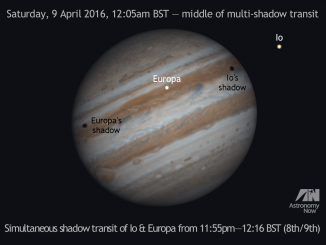
The largest man-made structure in orbit is the 450-tonne International Space Station (ISS), a satellite so big — 73 × 109 × 20 metres — that it can be seen from the most light-polluted town or city. Fortunately for us, its current orbit carries it over the British Isles and Western Europe for the next few nights, appearing like a slowly moving bright ‘star’ occasionally rivalling Venus in brightness, crossing the sky in an arc from west to east.

Using Astronomy Now’s Almanac to make ISS viewing predictions
Many of you may have used our online Almanac to obtain information about lunar phases, or the rising and setting of the Sun, Moon and planets for wherever you may live, but the Almanac can also tell you when and where to see the International Space Station.
In the Almanac, select the closest city to your location from the Country and City pull-down menus before ensuring that the box beside Add ISS passes? has a tick in it. The UK uses GMT in January, so the Daylight Savings Time? box should be unchecked. The table underneath the Moon phase data then shows nighttime passes of the International Space Station over your chosen location during the next few days, if any.
Here is a recent example computed for Cardiff: For the given Date in year/month/day format, Local Time is the instant the ISS first becomes visible and Duration indicates the length of the sighting in minutes. At the given Local Time, look in the direction indicated by Approach and, weather permitting, you should see the ISS as a slowly moving, bright “star”.
For the given Date in year/month/day format, Local Time is the instant the ISS first becomes visible and Duration indicates the length of the sighting in minutes. At the given Local Time, look in the direction indicated by Approach and, weather permitting, you should see the ISS as a slowly moving, bright “star”.
Max. elevation is how high the Station will get above your horizon (90° is overhead, while 20° is about the span of an outstretched hand at arm’s length) and Departure indicates where the ISS will be when it vanishes from sight. Sometimes an appearance or disappearance occurs well up in the sky when the Station emerges into sunlight or slips into Earth’s shadow, respectively.
In the example above, as seen from the Welsh capital on the evening of Wednesday, 30 January, the ISS first appeared 18° (twice the span of a fist at arm’s length) above the west-southwest (WSW) horizon at 6:02pm in a viewing window lasting four minutes. It attained a peak altitude of 66° above the southwest (SW) horizon before fading into Earth’s shadow 27° above the eastern (E) horizon around 6:06pm (all times GMT).
Important note: the precise timing of an ISS pass is highly location specific, plus the orbit of the spacecraft is subject to change due to periodic boosts to a higher orbit or to avoid debris, hence predictions made on the day are more accurate.



